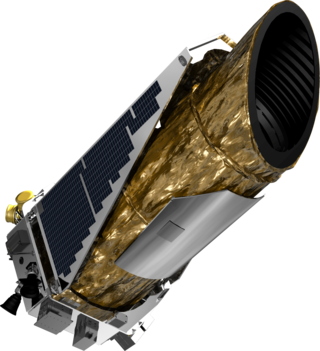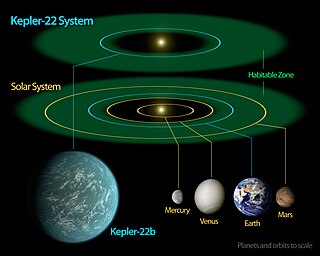
Johannes Kepler was a German astronomer, mathematician, astrologer, natural philosopher and writer on music. He is a key figure in the 17th-century Scientific Revolution, best known for his laws of planetary motion, and his books Astronomia nova, Harmonice Mundi, and Epitome Astronomiae Copernicanae. These works also provided one of the foundations for Newton's theory of universal gravitation.

In astronomy, Kepler's laws of planetary motion, published by Johannes Kepler between 1609 and 1619, describe the orbits of planets around the Sun. The laws modified the heliocentric theory of Nicolaus Copernicus, replacing its circular orbits and epicycles with elliptical trajectories, and explaining how planetary velocities vary. The three laws state that:
- The orbit of a planet is an ellipse with the Sun at one of the two foci.
- A line segment joining a planet and the Sun sweeps out equal areas during equal intervals of time.
- The square of a planet's orbital period is proportional to the cube of the length of the semi-major axis of its orbit.

SN 1604, also known as Kepler's Supernova, Kepler's Nova or Kepler's Star, was a Type Ia supernova that occurred in the Milky Way, in the constellation Ophiuchus. Appearing in 1604, it is the most recent supernova in the Milky Way galaxy to have been unquestionably observed by the naked eye, occurring no farther than 6 kiloparsecs from Earth. Before the adoption of the current naming system for supernovae, it was named for Johannes Kepler, the German astronomer who described it in De Stella Nova.

A terrestrial planet, telluric planet, solid planet, or rocky planet, is a planet that is composed primarily of silicate rocks or metals. Within the Solar System, the terrestrial planets accepted by the IAU are the inner planets closest to the Sun: Mercury, Venus, Earth, and Mars. Among astronomers who use the geophysical definition of a planet, some planetary-mass satellites, e.g. Earth's Moon and Jupiter's Io and sometimes Europa, may also be considered terrestrial planets; and so maybe the rocky protoplanet-asteroids Pallas and Vesta. The terms "terrestrial planet" and "telluric planet" are derived from Latin words for Earth, as these planets are, in terms of structure, Earth-like. Terrestrial planets are generally studied by geologists, astronomers, and geophysicists.

The Kepler space telescope is a disused space telescope launched by NASA in 2009 to discover Earth-sized planets orbiting other stars. Named after astronomer Johannes Kepler, the spacecraft was launched into an Earth-trailing heliocentric orbit. The principal investigator was William J. Borucki. After nine and a half years of operation, the telescope's reaction control system fuel was depleted, and NASA announced its retirement on October 30, 2018.
Johannes Kepler (1571–1630) was a key figure in the scientific revolution.

Kepler-7b is one of the first five exoplanets to be confirmed by NASA's Kepler spacecraft, and was confirmed in the first 33.5 days of Kepler's science operations. It orbits a star slightly hotter and significantly larger than the Sun that is expected to soon reach the end of the main sequence. Kepler-7b is a hot Jupiter that is about half the mass of Jupiter, but is nearly 1.5 times its size; at the time of its discovery, Kepler-7b was the second most diffuse planet known, surpassed only by WASP-17b. It orbits its host star every five days at a distance of approximately 0,06 AU. Kepler-7b was announced at a meeting of the American Astronomical Society on January 4, 2010. It is the first extrasolar planet to have a crude map of cloud coverage.

Kepler-10b is the first confirmed terrestrial planet to have been discovered outside the Solar System by the Kepler Space Telescope. Discovered after several months of data collection during the course of the NASA-directed Kepler Mission, which aims to discover Earth-like planets crossing in front of their host stars, the planet's discovery was announced on January 10, 2011. Kepler-10b has a mass of 3.72±0.42 Earth masses and a radius of 1.47 Earth radii. However, it lies extremely close to its star, Kepler-10, and as a result is too hot to support life as we know it. Its existence was confirmed using measurements from the W.M. Keck Observatory in Hawaii.

Kepler-10c is an exoplanet orbiting the G-type star Kepler-10, located around 608 light-years away in Draco. Its discovery was announced by Kepler in May 2011, although it had been seen as a planetary candidate since January 2011, when Kepler-10b was discovered. The team confirmed the observation using data from NASA's Spitzer Space Telescope and a technique called BLENDER that ruled out most false positives. Kepler-10c was the third transiting planet to be confirmed statistically, after Kepler-9d and Kepler-11g. The Kepler team considers the statistical method that led to the discovery of Kepler-10c as what will be necessary to confirm many planets in Kepler's field of view.
Kepler-40, formerly known as KOI-428, is an F-type star in the constellation Cygnus. Kepler-40 is known to host at least one planet, Kepler-40b. The star is approximately 1.5 times more massive than the Sun, and is over two times its size; it was, at upon its discovery, the largest yet discovered with a transiting planet in its orbit. Kepler-40 was first noted as home to a possible transiting object by the Kepler spacecraft; the data on the system was released to the public. A team of French and Swiss scientists used follow-up data to determine the existence of the Hot Jupiter planet Kepler-40b, and later had their results published in a scientific journal on January 4, 2011.

Kepler-22b is an exoplanet orbiting within the habitable zone of the Sun-like star Kepler-22. It is located about 640 light-years from Earth in the constellation of Cygnus. It was discovered by NASA's Kepler Space Telescope in December 2011 and was the first known transiting planet to orbit within the habitable zone of a Sun-like star, where liquid water could exist on the planet's surface. Kepler-22 is too dim to be seen with the naked eye.

Maximilian Kepler-Różycki is a German professional baseball outfielder for the Minnesota Twins of Major League Baseball (MLB). He made his MLB debut in 2015. Before signing with the Twins, he played for Buchbinder Legionäre Regensburg of Bundesliga. He bats and throws left-handed. He holds the record for home runs hit in a career by a German-born player.
Kepler-47 is a binary star system in the constellation Cygnus located about 3,420 light-years away from Earth. The stars have three exoplanets, all of which orbit both stars at the same time, making this a circumbinary system. The first two planets announced are designated Kepler-47b, and Kepler-47c, and the third, later discovery is Kepler-47d. Kepler-47 is the first circumbinary multi-planet system discovered by the Kepler mission. The outermost of the planets is a gas giant orbiting within the habitable zone of the stars. Because most stars are binary, the discovery that multi-planet systems can form in such a system has impacted previous theories of planetary formation.
Kepler-80, also known as KOI-500, is a red dwarf star of the spectral type M0V. This stellar classification places Kepler-80 among the very common, cool, class M stars that are still within their main evolutionary stage, known as the main sequence. Kepler-80, like other red dwarf stars, is smaller than the Sun, and it has both radius, mass, temperatures, and luminosity lower than that of our own star. Kepler-80 is found approximately 1,223 light years from the Solar System, in the stellar constellation Cygnus, also known as the Swan.

Kepler-62f is a super-Earth exoplanet orbiting within the habitable zone of the star Kepler-62, the outermost of five such planets discovered around the star by NASA's Kepler spacecraft. It is located about 980 light-years from Earth in the constellation of Lyra.

Kepler-442b is a confirmed near-Earth-sized exoplanet, likely rocky, orbiting within the habitable zone of the K-type main-sequence star Kepler-442, about 1,206 light-years (370 pc) from Earth in the constellation of Lyra.

Kepler-452b is a super-Earth exoplanet orbiting within the inner edge of the habitable zone of the sun-like star Kepler-452 and is the only planet in the system discovered by Kepler. It is located about 1,800 light-years (550 pc) from Earth in the constellation of Cygnus.

Kepler-452 is a G-type main-sequence star located about 1,800 light-years away from Earth in the Cygnus constellation. Although similar in temperature to the Sun, it is 20% brighter, 3.7% more massive and 11% larger. Alongside this, the star is approximately six billion years old and possesses a high metallicity. Thus, Kepler-452 can be considered a solar twin, although it could be considered a solar analog due to its age.
Kepler-419 is an F-type main-sequence star located about 3,400 light years from Earth in the constellation Cygnus. It is located within the field of vision of the Kepler spacecraft, the satellite that NASA's Kepler Mission used to detect planets that may be transiting their stars. In 2012, a potential planetary companion in a very eccentric orbit was detected around this star, but its planetary nature was not confirmed until 12 June 2014, when it was named Kepler-419b. A second planet was announced orbiting further out from the star in the same paper, named Kepler-419c.
















